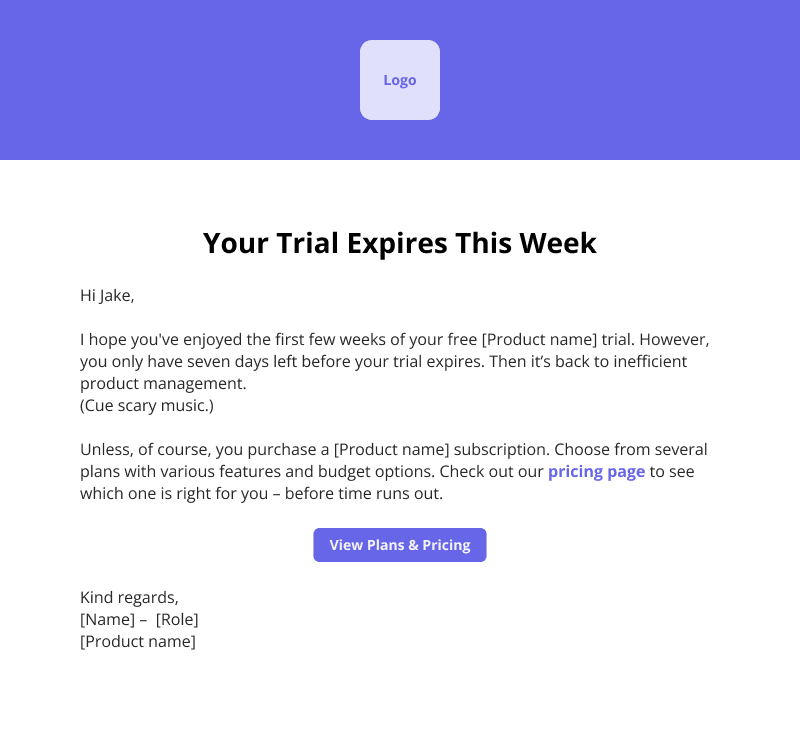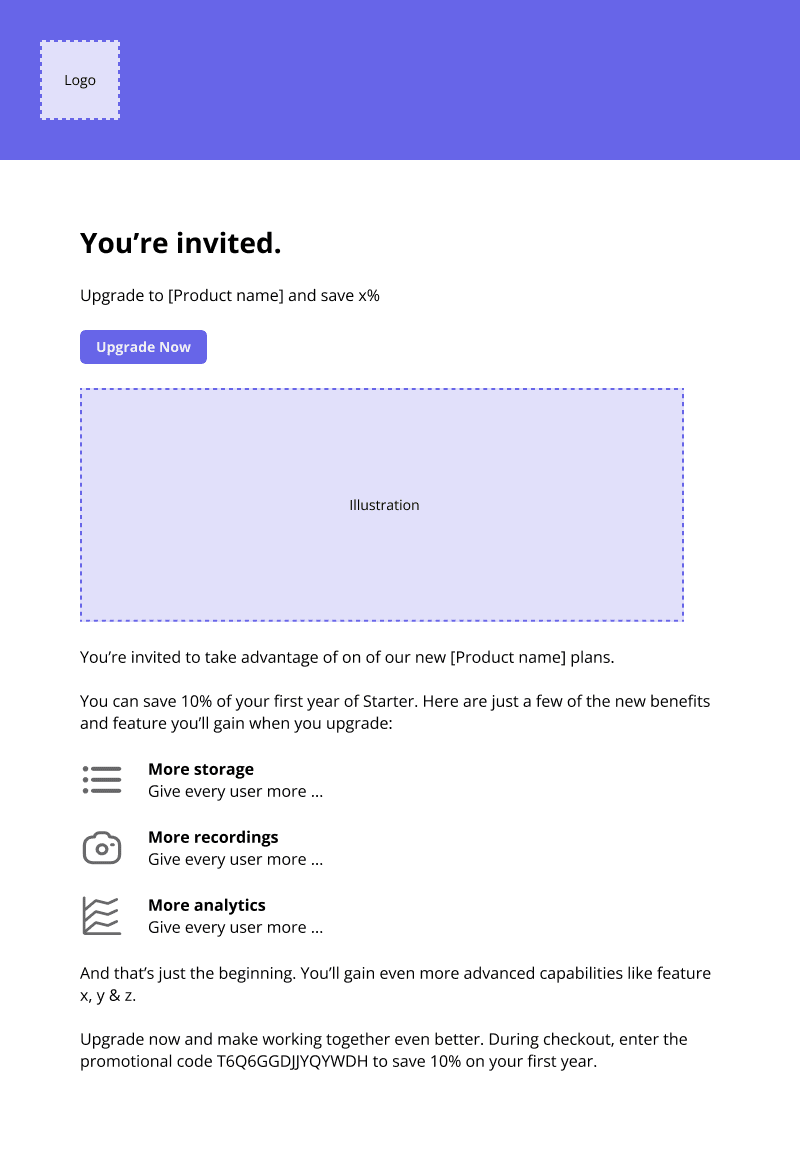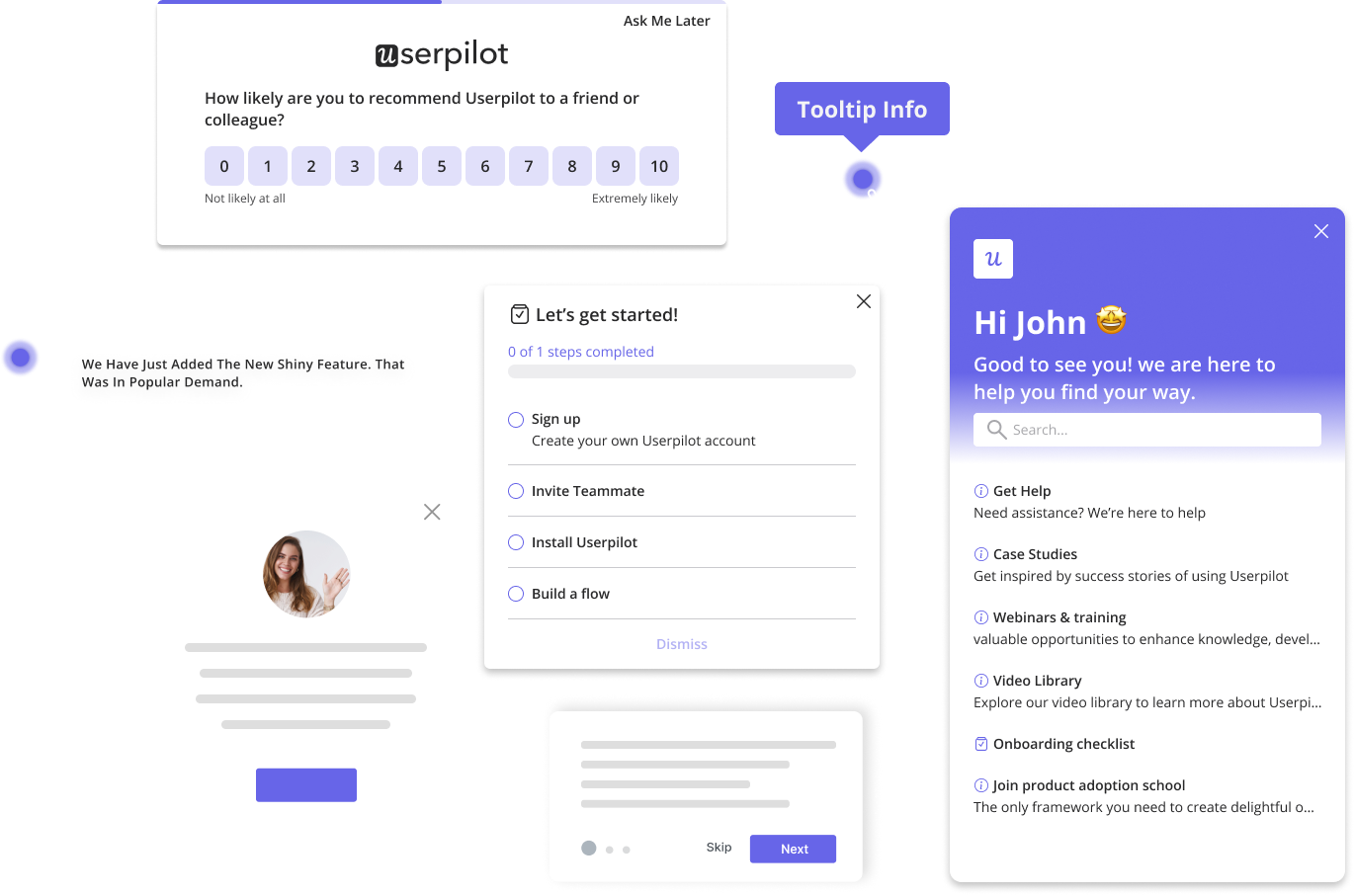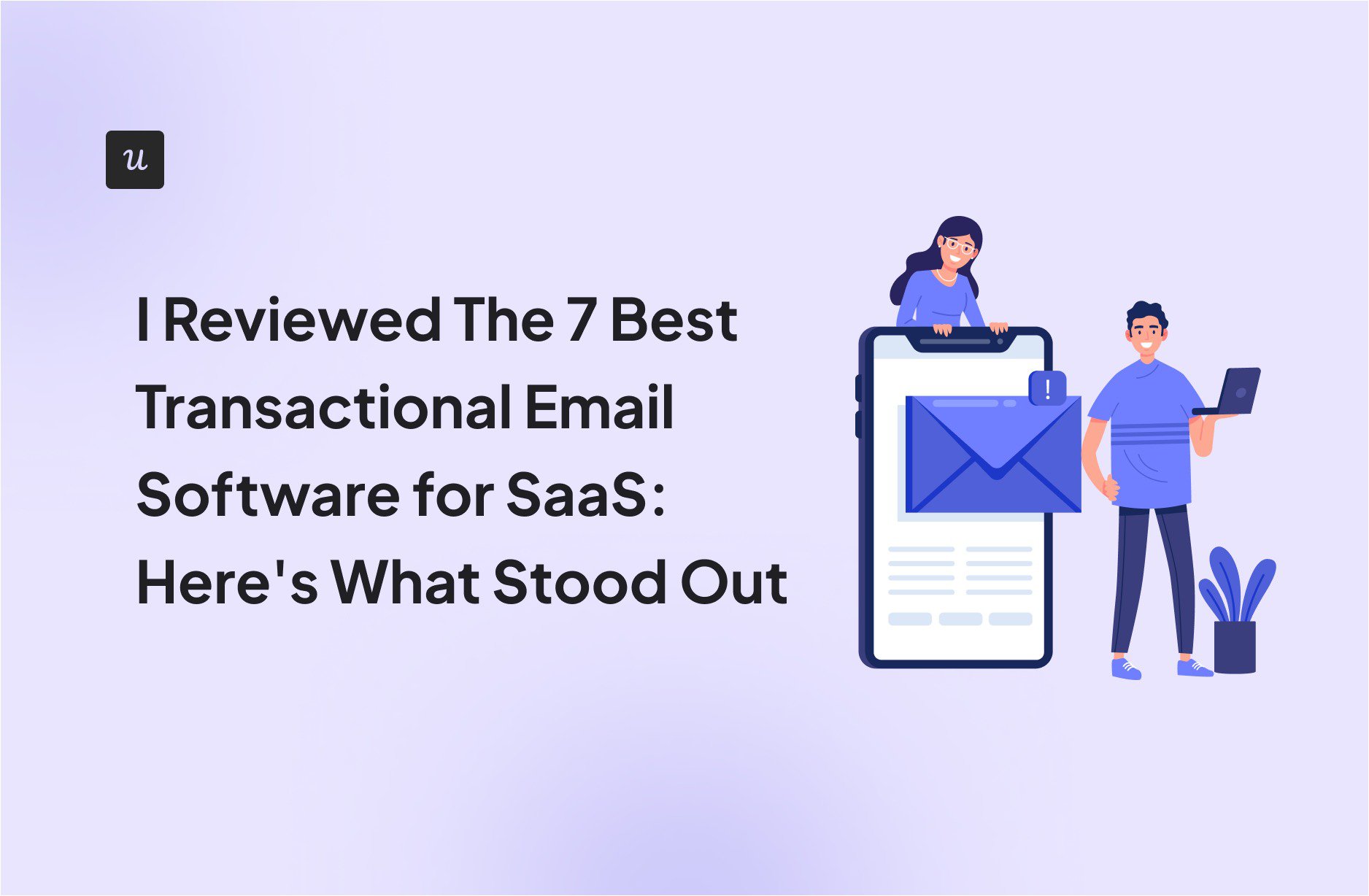
I Reviewed The 7 Best Transactional Email Software for SaaS: Here’s What Stood Out
As a PMM at a SaaS company, I’ve had to learn the hard way that picking a transactional email software isn’t just a technical choice, but also a growth decision. Every account setup, password reset, or renewal reminder email is a direct touchpoint with users that shapes their experience. If those emails fail to deliver, arrive late, or feel off-brand, the impact goes far beyond a support ticket. It affects customer success, retention, and ultimately, revenue.
In this blog, I’ve laid out a detailed review of my top 7 picks for transactional email services, covering their key features, pricing, and trade-offs I noticed, so you can skip the trial-and-error phase and go straight to picking what fits your needs.
Try Userpilot Now
See Why 1,000+ Teams Choose Userpilot

My criteria for evaluating transactional email software
To evaluate transactional email service providers, I signed up for free trials wherever they were available and created a series of test emails to see each tool in action. Throughout the process, I documented everything I encountered: what worked well, what fell short, and how intuitive the overall experience felt.
For platforms without free trials or those priced beyond the scope of my experiment, I turned to real user feedback. I analyzed reviews from G2, Capterra, and discussions on Reddit to get an unbiased perspective on their performance and reliability.
Here’s what I looked at when comparing platforms:
- Deliverability: If emails don’t reach the inbox, nothing else matters. I looked at each platform’s sender reputation management, bounce handling, and built-in tools to maintain high deliverability rates.
- Ease of use: If setup takes days or requires engineering support for every change, adoption suffers. I evaluated how intuitive the UI is, how fast it is to build and test a message, and whether product teams can handle it without needing to loop in developers every time.
- Customization and personalization: Look for platforms that allow dynamic content, user-specific variables, and advanced email personalization rules so every message feels relevant to the recipient and aligned with your brand.
- Performance and analytics insights: Without visibility into metrics like delivery rate, opens, and clicks, you can’t troubleshoot issues or improve your strategy over time.
- Price and value for money: Cost alone doesn’t tell the whole story. The best software balances pricing with functionality, offering the features you need without forcing you to overpay for things you’ll never use.
- Scalability: As your business grows, your email volume and workflow complexity will increase. A scalable platform ensures consistent performance at higher volumes and saves you from painful migrations later.
- Customer support: Transactional emails are mission-critical. When deliverability dips or an integration breaks, you can’t wait days for help. Look for providers with responsive, knowledgeable support teams that can resolve issues fast and keep disruptions to a minimum.
The best transactional email platforms at a glance
| Tool | Best for | Pricing | Deliverability | Pros and Cons |
|---|---|---|---|---|
| Userpilot | In-app onboarding, product messaging + transactional emails | From $299/month; 14-day free trial | High (via integrated infrastructure) | ✅ No-code builder, visual editor, event-based targeting, analytics ⚠️ Not suitable if you only want backend email delivery |
| Postmark | Fast, reliable transactional email delivery | From $15/month for 10,000 emails | Excellent (fastest average delivery times) | ✅ Developer-friendly, simple pricing, separate Message Streams for promotional vs transactional ⚠️ No visual editor, more dev-focused |
| Amazon SES | Low-cost, high-scale backend email sending | Pay-as-you-go. $0.10 per 1,000 emails | High (with proper setup and authentication) | ✅ Cheapest at scale, highly configurable ⚠️ Requires technical setup, no visual editor, no support for non-technical teams |
| SendGrid | Combining marketing and transactional email | Free tier available; paid plans from $19.95/month | Good, but can fluctuate without custom domain | ✅ Flexible API, SMTP, marketing and transactional tools ⚠️ Support and UI issues reported, inconsistent deliverability |
| Mailchimp | Users already using Mailchimp for marketing | Transactional add-on starts from $20 for 25K emails | Moderate to good (if authenticated properly) | ✅ Easy integration with Mailchimp campaigns ⚠️ Must use Mailchimp core product, fewer controls over message timing |
| Mailgun | Developer-first teams who want full control | Pay-as-you-go; $35/month for 50K emails | Strong (esp. with dedicated IPs) | ✅ Scalable, detailed logs, great APIs ⚠️ Requires setup, no built-in visual builder for templates |
| Hubspot | All-in-one CRM and email platform | Starts from $50/month; Transactional upgrade extra | Moderate to strong (depends on package) | ✅ Unified CRM + email tools + marketing ⚠️ Expensive at scale, limited customization in transactional flows |
My detailed review of the top 7 best transactional email services
To help you decide on the right tool, for each, I’m laying out:
- The top use case
- Overall G2 rating
- Standout features
- Pros and cons
- Pricing
So you can see what fits your business size, industry, and individual needs.
1. Userpilot: Best for PLG teams running omnichannel campaigns
G2 Rating: 4.6/5 (based on 800+ reviews)
Ideal for: mid-to-large SaaS companies running integrated PLG campaigns.
When we built Userpilot, we set out to create a platform that could manage the entire product-led growth journey end-to-end.
If you’re trying to deliver consistent communication across multiple channels, this is the exact challenge we designed Userpilot to solve. Our platform unifies in-app experiences, push notifications, and transactional email in one no-code workflow builder without relying on engineering or patching together external systems.
Key features:
- Predefined templates to get started quickly: We have a library with common transactional use case templates like welcome emails, password reset emails, or invoice emails, so you can start sending emails right away, without spending any time on writing code or choosing a design.
- Drag-and-drop builder: Our no-code editor gives you complete control over email design, allowing you to pick fonts, colors, and width for pixel-perfect branding. You can add sections like buttons, columns, images, videos, HTML, or dividers, all of this without writing a single line of code.
- Embed signatures: You can embed a consistent signature block that includes name, role, and company contact details.
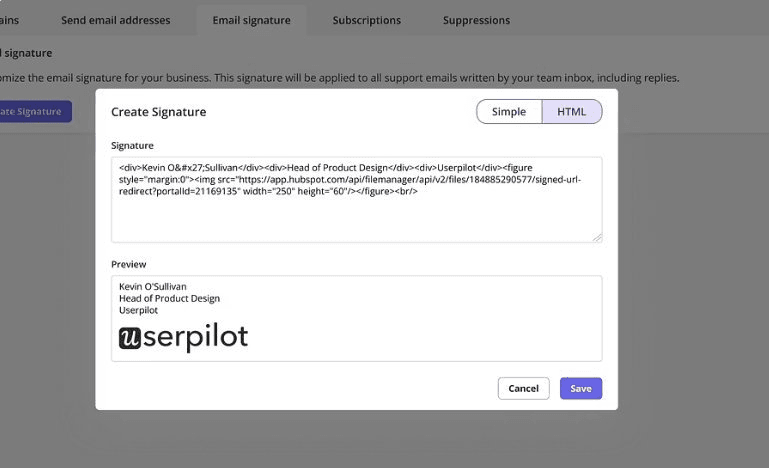
- AI-assisted copy: Userpilot includes an AI assistant built into the email editor that helps you refine your messaging according to your needs.
- Dynamic attribute personalization: You can insert user-specific data into your emails using attributes from your product. This includes things like first name, plan type, or company name. These variables can be added to both subject lines and the message body.
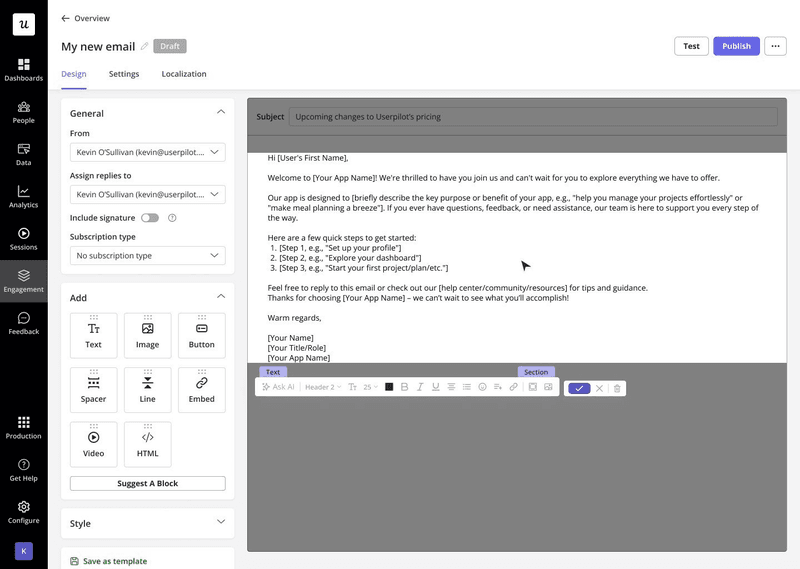
- Email localization: Craft email content versions in multiple languages so every user reads in their native tongue.
- Throttling and frequency caps: To avoid deliverability issues, spread out your email sends over time. It’s also helpful to cap the number of emails each user receives during a given period to prevent overload.
- Multi-domain & sender management: Userpilot lets you verify multiple domains and lets you assign specific From and Reply-To addresses for each message.
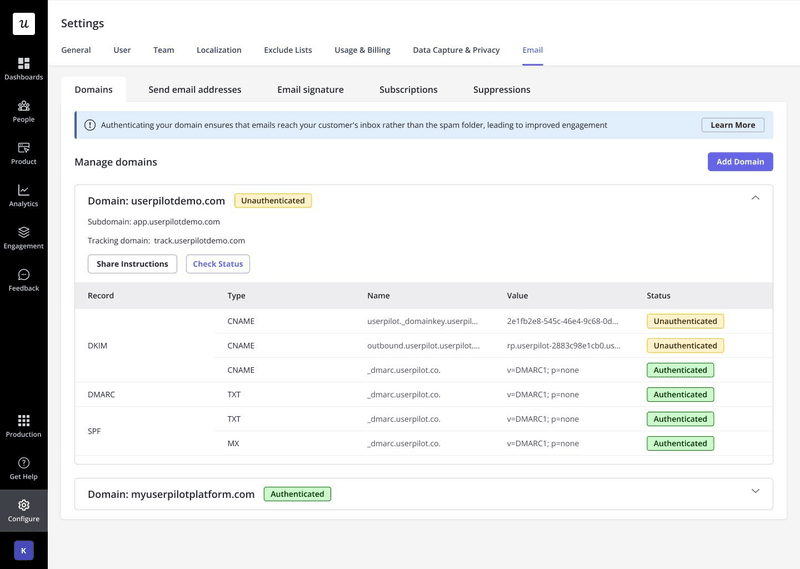
- Immediate or scheduled delivery: You can trigger emails instantly or set a specific time and date for delivery. You can also align delivery by the user’s time zone, which is useful for transactional messages like plan expiration or billing notices.

- Email performance metrics: Each campaign shows performance metrics including sends, delivery success, open rate, click-through rate, unsubscribes, and bounce rate. These numbers update in real time and are shown directly in the dashboard.
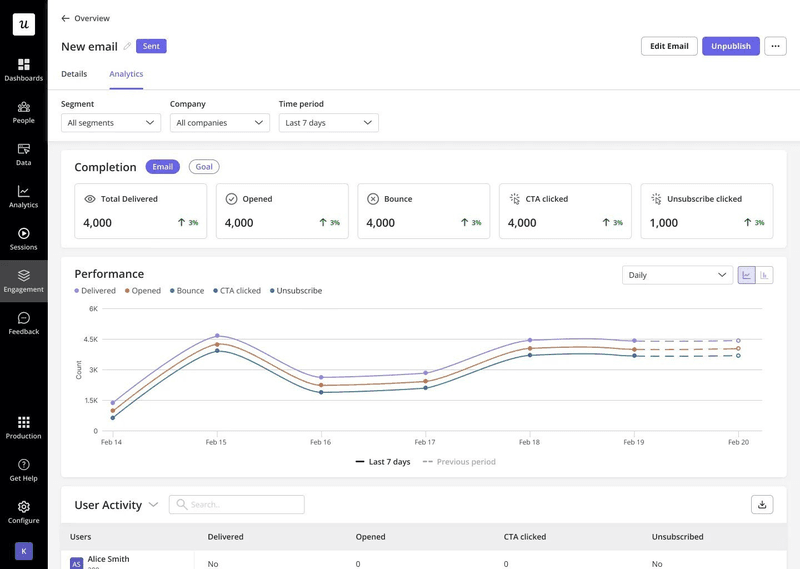
- Cross-channel correlation: Userpilot tracks what users do after they open or click on an email. You can see whether they log in, use a feature, or drop off. This helps you understand which transactional emails lead to the desired user behavior.
Pricing
- Starter: From $299/month (billed annually). For teams with up to 2,000 MAUs. Includes in-app engagement, usage tracking, segmentation, and NPS.
- Growth: Custom pricing includes everything in Starter, plus product analytics, event capture, surveys, localization, and resource center. Email messaging included (100,000 emails/month).
- Enterprise: Custom pricing includes everything in Growth, plus SAML SSO, premium integrations, and priority support. Email included (100,000 sends/month).
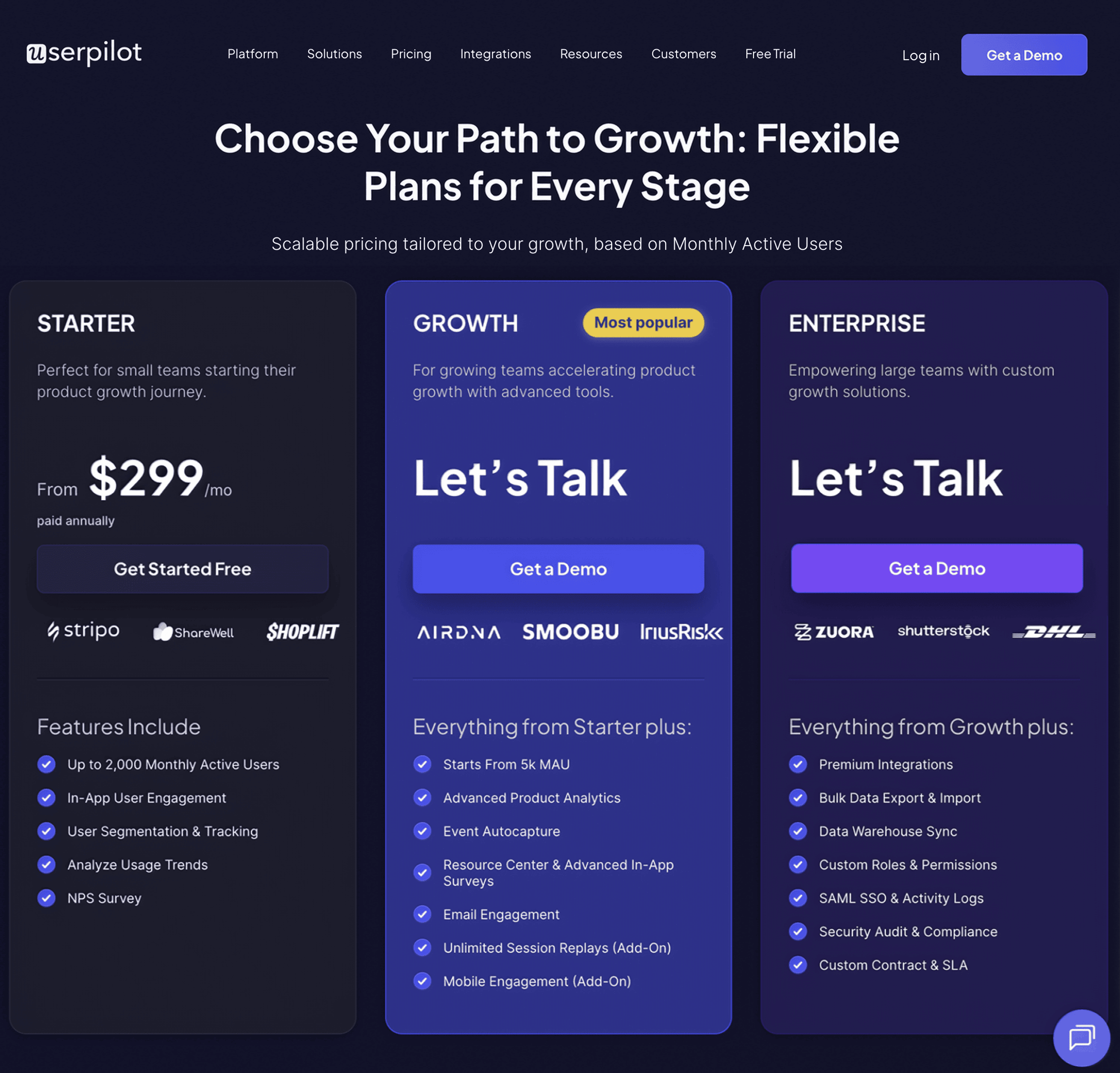
Pros of Userpilot
- No-code automation for faster deployment: You don’t need engineering resources to set up or update transactional email workflows.
- Reduced tool overhead and complexity: For SaaS businesses already using Userpilot, managing transactional emails within the same platform simplifies workflows, reduces costs, and ensures messaging consistency across channels.
- Simple, transparent pricing by MAUs: There are no email overage fees. Pricing is tied to active users, so teams don’t have to monitor send volume or budget for unpredictable usage spikes.
Cons of Userpilot
- Not a standalone email platform: Userpilot works best if you’re already using it for in-app messaging. If you’re only looking to send transactional emails, it may feel too feature-heavy.
- Price point for small startups: Might feel steep for early-stage teams with limited budgets or lower user volumes.
2. Postmark: Best for fast, developer-first transactional email delivery
G2 rating: 4.6/5 (based on 20+ reviews)
Ideal for: Developers who care about fast transactional email delivery and don’t need built-in marketing tools or visual editors.
Postmark is built for one job: sending transactional emails fast and reliably. The platform separates transactional messages from bulk sends, which helps protect deliverability and sender reputation. But you won’t find visual editors, drag-and-drop tools, or marketing automation here.
There are built-in templates for common flows like password reset emails and invoices, but customizing them requires HTML. The interface is simple but developer-friendly, with detailed logs, message tracking, and 45-day retention.
That said, Postmark is not built for lifecycle marketing. There’s no scheduler, no bulk send segmentation, and no in-app messaging. If you want to run marketing emails alongside transactional ones, you’ll need to pair them with a separate email marketing tool.
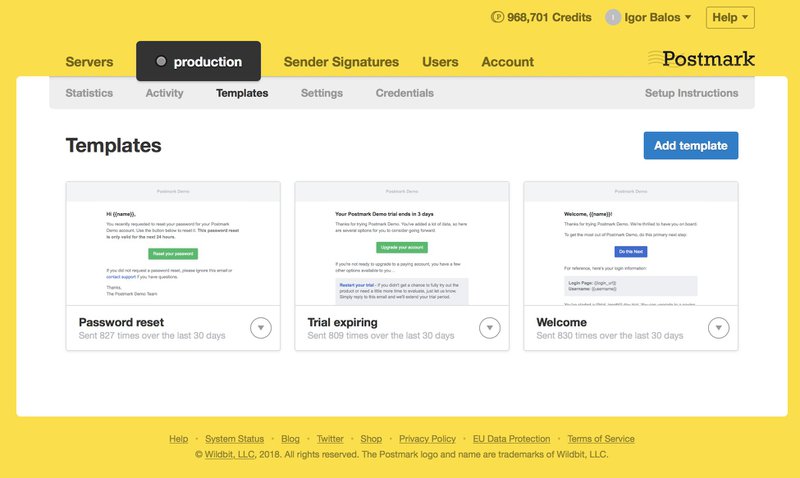
Key features:
- Message streams for separating transactional and bulk traffic.
- SMTP and REST API integration with official language libraries.
- Prebuilt transactional email templates.
- Detailed message tracking and 45-day activity retention.
Pricing
Postmark’s paid plans start at $15/month for 10,000 emails on the Basic plan, with support for up to 4 users and 5 servers. The Pro plan is $60.50/month for 50,000 emails and includes inbound email. The Platform plan starts at $138/month for 125,000 emails with unlimited users and servers. Extra emails cost between $1.20–$1.80 per 1,000, depending on the plan.
Pros of Postmark
- Extremely fast delivery speeds: One of the best in the category for time-to-inbox, ideal for time-sensitive emails like login codes or order confirmations.
- Clear, helpful documentation: Setup guides are simple to follow, even if you’re integrating via API. Great developer experience.
- Detailed analytics with no frills: Each email retains open, click, bounce, and spam complaint data for 45 days, helping you troubleshoot without fuss.
Cons of Postmark
- Narrow focus on transactional messages: There is no built-in email marketing automation, bulk emailing, or list management.
- US-only data storage: Data hosting is restricted to the US, which may complicate GDPR compliance for EU-based teams.
- Requires coding for design changes: There is no visual editor. Every template must be customized using HTML and CSS, which may require developer time.
3. Amazon SES: Best for low-cost, high-volume transactional email delivery
G2 rating: 4.3/5 (based on 170+ reviews)
Ideal for: Technical teams, e-commerce companies that handle high-volume outbound messages.
Amazon SES is built for scale and cost-efficiency. It’s not flashy as there’s no UI for editing emails, no visual campaign flows, and no plug-and-play templates. But if you’re sending millions of transactional messages and want to keep costs low, it works.
I tested it by connecting via both SMTP and the SES API. It took some time to configure everything, like setting up IAM roles, verifying domains, and editing DNS records, which isn’t beginner-friendly. But once it was running, it had excellent deliverability. My test emails landed reliably, and event tracking through CloudWatch helped me monitor bounces and complaints in real time.
It works well if you already use other AWS tools like S3, CloudWatch, or Lambda. But it’s clearly built for technical teams. If your marketing team needs access, you’ll probably need to layer another tool on top.
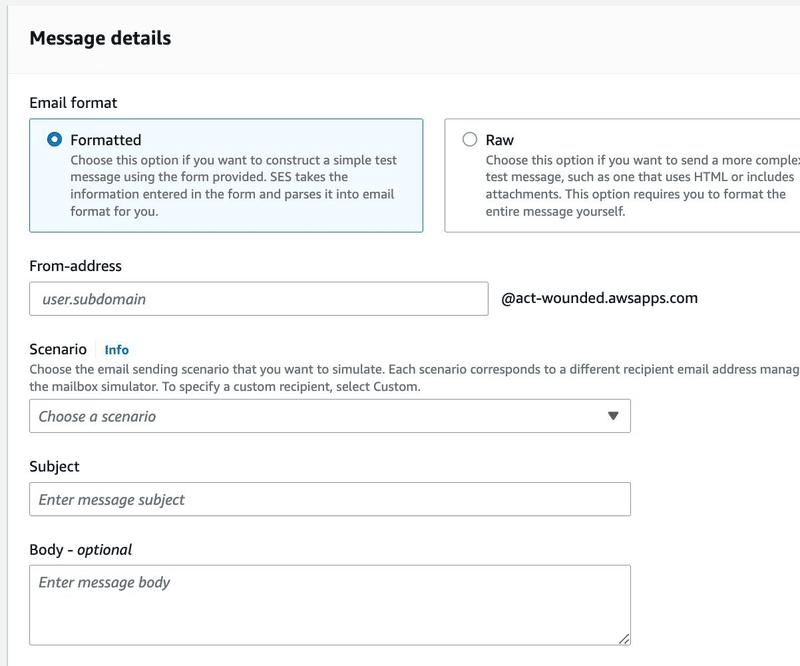
Key features
- SMTP and REST API support with official SDKs.
- Dynamic templates managed via API.
- CloudWatch and SNS integration for bounce/complaint tracking.
- Custom sending limits and rate control.
Pricing
Amazon SES is pay-as-you-go with no monthly base fee. The first 62,000 emails per month are free if you send from an Amazon EC2 instance. After that, it’s $0.10 per 1,000 emails. If you need dedicated IP addresses, each one costs $24.95/month. Attachments are billed separately at $0.12/GB.
Pros of Amazon SES
- Extremely low cost at scale: One of the cheapest options for high-volume email, especially if you’re already using EC2.
- Full control through AWS: SES integrates with the rest of the AWS stack (CloudWatch, SNS, S3), giving technical teams full flexibility.
- Good deliverability tools: Dedicated IPs, feedback loops, and sending dashboards help maintain sender reputation and deliverability.
- Global infrastructure: Emails are processed in multiple AWS regions, which can help reduce latency for global apps.
Cons of Amazon SES
- Not beginner-friendly: The setup involves domain verification, IAM roles, and API configuration. It’s not intuitive for non-technical users.
- No visual builder or UI tools: Everything is code-based. You’ll need to create and manage templates via API or the CLI.
- No prebuilt flows or templates: There are no built-in templates for common transactional emails like password resets or invoices.
- No live support unless you pay extra: Free tier users rely on documentation or forums. AWS premium support is expensive and sold separately.
4. SendGrid: Best for teams that need balance of APIs and email marketing features
G2 rating: 4.0/5 (based on 350+ reviews)
Ideal for: SaaS and product-led growth teams that need both reliable transactional email delivery and the flexibility of email marketing software.
SendGrid lets you send both transactional and bulk emails from one place. In my tests, transactional email delivery was solid, and nothing went to the spam folder. The platform keeps marketing and transactional messages on separate IPs, which helps protect sender reputation.
Setup took about 20 minutes. I used both SMTP and API. The docs were clear, but I had to rely on forums until I upgraded for better support. There’s a drag-and-drop builder and built-in email templates for flows like password resets and receipts. You can also create custom layouts and save them.
Marketing automation is available, but basic. The workflow builder wasn’t as smooth as other transactional email delivery service tools I’ve tried. If you want advanced lifecycle emails or visual logic, it might feel limited. SendGrid works well if your team includes both developers and marketers.
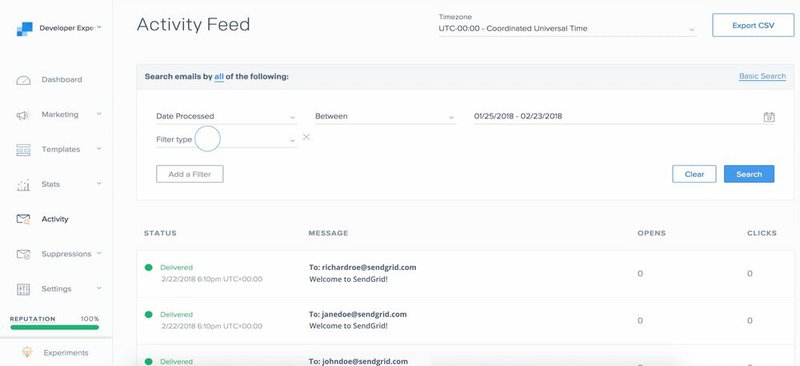
Key features:
- REST API and SMTP relay for sending transactional email.
- Drag-and-drop editor for building responsive email templates.
- Event webhooks for tracking email delivery, bounces, opens, and spam folder issues.
- Built-in segmentation and automation tools.
- Supports both transactional and bulk emails.
Pricing
SendGrid offers a free trial with 100 emails/day. The essentials plan starts at $19.95/month for 50,000 emails. The pro plan begins at $89.95/month and includes a dedicated IP and sub-user management. Email volume pricing is tiered; that is, higher tiers offer lower per-email rates.
Pros of SendGrid
- Reliable for transactional email delivery: Emails sent through the transactional email API landed in inboxes during testing. Deliverability held up well when using authenticated domains.
- Built-in drag-and-drop editor: Includes responsive email templates and a visual editor, useful if you’re sending both transactional and bulk messages from one platform.
- Scales well: Suited for teams sending millions of emails. You can add sub-users, throttle sending rates, and use multiple IPs to manage traffic and sender reputation.
Cons of SendGrid
- Learning curve with advanced features: Managing transactional and marketing emails together takes some getting used to. The marketing automation builder feels limited compared to other email marketing services.
- Support depends on your plan: Free-tier users rely mostly on documentation and forums. Live chat and ticketing support are reserved for paid users.
- UI can feel outdated: The dashboard is functional, but navigating between tools like templates, stats, and marketing campaigns takes time to get used to.
5. Mailchimp: Best for teams already using Mailchimp Marketing
G2 review: 4.4/5 (based on 5000+ reviews)
Ideal for: Companies that want marketing and transactional emails under one roof.
Mailchimp transactional email is only available if you’re already using a Mailchimp account for marketing. I wouldn’t recommend it if you’re starting from scratch, but for existing Mailchimp users, it’s convenient to have transactional sending built in.
The UI feels a bit outdated and isn’t as intuitive as other tools I’ve used. There’s no visual email builder. You’ll need to create templates in raw HTML and manage them through the API. That wasn’t a dealbreaker for me, but it’s not very friendly for teams who expect drag-and-drop editors.
Key features:
- SMTP and REST API support for sending transactional email.
- Message tagging, metadata, and advanced scheduling options.
- Webhooks for tracking delivery events, bounces, opens, and spam folder placement.
- Built-in deliverability tools like custom tracking domains and suppression list handling.
Pricing
Mailchimp transactional email is available only as a paid add-on to Mailchimp’s marketing plans. It follows a credit-based system, where one block (25,000 emails) costs $20. Credits are valid for the month of purchase and do not carry over.
Pros of Mailchimp Transactional
- Seamless Mailchimp integration: Works well for teams already using Mailchimp for email marketing. You can manage both transactional and marketing emails within one ecosystem.
- Solid documentation: Mailchimp transactional comes with developer-friendly guides for both SMTP and API setup.
- Email and contact management under one roof: Combines Mailchimp’s marketing automation tools with transactional messaging for a unified approach.
Cons of Mailchimp Transactional
- Locked behind marketing plans: You can’t use Mailchimp transactional email as a standalone service. It requires a Mailchimp Marketing Platform subscription.
- No visual builder for transactional templates: Unlike some competitors, it doesn’t offer a drag-and-drop interface. You’ll need to edit raw HTML.
- Setup may need dev help: Setting up DKIM, SPF, and domain records can be tricky if you’re not familiar with DNS.
- No rollover for unused credits: If you don’t use all your Mailchimp transactional blocks in a month, they expire, which leads to wasted email volume.
6. Mailgun: Best for dev teams sending high-volume emails with deep analytics
G2 rating: 4.2/5 (based on 250+ reviews)
Ideal for: SaaS teams sending bulk plus transactional emails with API control and analytics.
Mailgun is a reliable transactional email service built for technical teams that send large volumes of transactional and bulk messages. It works well with backend systems and offers an application programming interface that’s flexible and well-documented.
There’s no visual editor, so you’ll need to build your templates in HTML. That might be a hurdle for less technical users. On the upside, the platform includes helpful features like send-time optimization and inbox placement testing. You also get access to chat support and phone support, though response times vary based on your plan and the complexity of the issue.
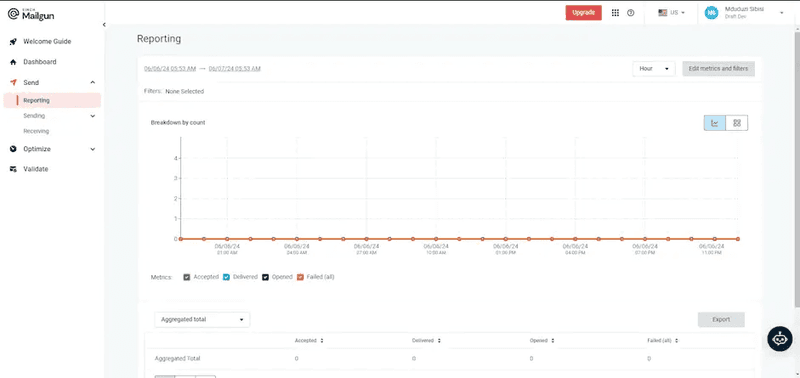
Key features:
- RESTful application programming interface plus SMTP integration.
- Event-level logging for delivery, opens, clicks, and bounce tracking.
- Webhook support for real-time processing and inbox-placement testing.
- Dedicated IP and reputation features to maintain high delivery rates.
Pricing:
Mailgun offers a free plan with 100 emails/day. Paid plans start at $15/month for 10,000 emails, $35/month for 50,000, and $90/month for 100,000. Higher tiers include better log retention, advanced routing, template APIs, and phone support. Extra emails and validations are billed separately.
Pros of Mailgun
- Powerful API-first design: Developers can script most tasks via the application programming interface more efficiently.
- Clear logs and metrics: Detailed delivery tracking helps uncover patterns and address issues immediately.
- Rich analytics and insight: You can query event logs, track metrics, and analyze by tag or campaign over 30-day history.
Cons of Mailgun
- No visual email builder: All templates must be handled in code, which isn’t ideal for non-developers.
- Additional costs for extra tools: Some advanced features like inbox placement testing, come at an extra price.
- Steeper delivery configuration: Setting up DKIM, SPF, webhooks, and IP pools takes effort, which may slow rollout.
7. HubSpot: Best for HubSpot CRM users wanting both transactional and marketing emails
G2 rating: 4.4/5 (based on 12,000+ reviews)
Ideal for: B2B SaaS teams on HubSpot, triggering transactional emails from marketing workflows.
HubSpot’s transactional email works well if your team already uses its CRM and marketing tools. You can send system messages like password resets or order confirmations through SMTP or API, while keeping everything linked to your contact records.
I had to validate the emails by configuring SPF, DKIM, and IP. The instructions were clear, and I didn’t run into any blockers. HubSpot also lets you tag emails as transactional, which skips opt-in checks and handles them differently from promotional messages.
The email service uses the same drag-and-drop builder as the rest of the platform, which helps non-technical users design templates quickly. It integrates well with HubSpot’s automation tools, so you can trigger transactional messages as part of a broader user journey.
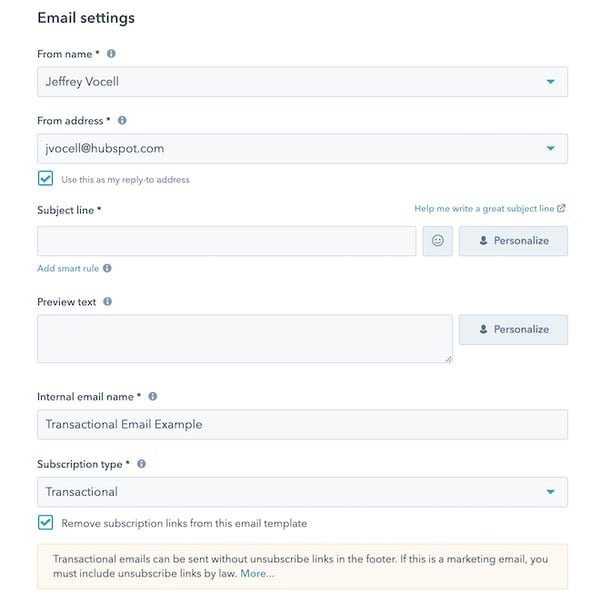
Key features:
- Real-time dashboards showing opens, clicks, bounces, and revenue attribution.
- Transactional API and SMTP support.
- Shared builder for marketing and transactional emails
- Built-in email deliverability analytics dashboard.
Pricing:
HubSpot’s transactional email is available as an add-on to the Marketing Hub Professional plan ($890/month) or Enterprise plan ($3,600/month). The transactional email add-on costs an additional $600/month.
Pros of HubSpot
- Centralized dashboard for email deliverability: Shows bounce rates, open rates, and key metrics in one view to help you spot issues quickly.
- CRM-linked messaging: Every email sent is connected to contact activity, which makes it easier to track engagement across support and service teams.
- Reliable chat support: Help is available via chat, which speeds up troubleshooting during setup or when testing domain configuration.
Cons of HubSpot
- No standalone access: You can’t use HubSpot’s transactional email without subscribing to one of its higher-tier plans.
- Manual domain setup: Verifying domains requires editing DNS records and setting up SPF and DKIM manually, which might need technical help.
- High entry cost: The transactional feature is part of a $600/month premium upgrade, available only to customers on already expensive marketing plans.
Choosing the right translational email service for your SaaS
Transactional emails aren’t just system messages; they’re key touchpoints that drive retention and revenue. Choosing the right platform makes all the difference.
Ready to simplify and supercharge your email strategy? Schedule a Userpilot demo today and see how easy it is to manage emails and in-app experiences in one place.

